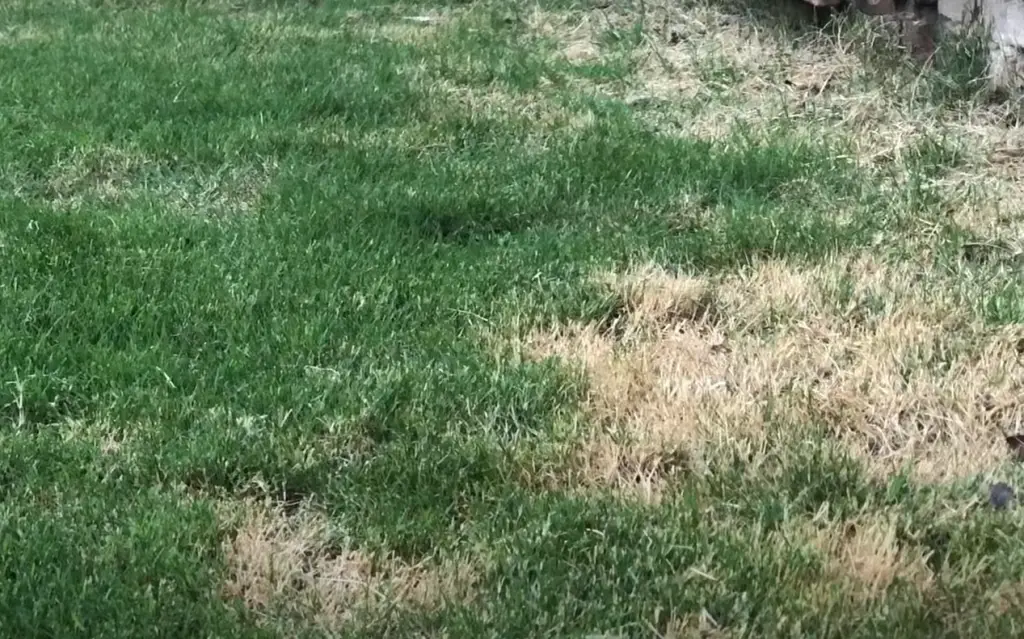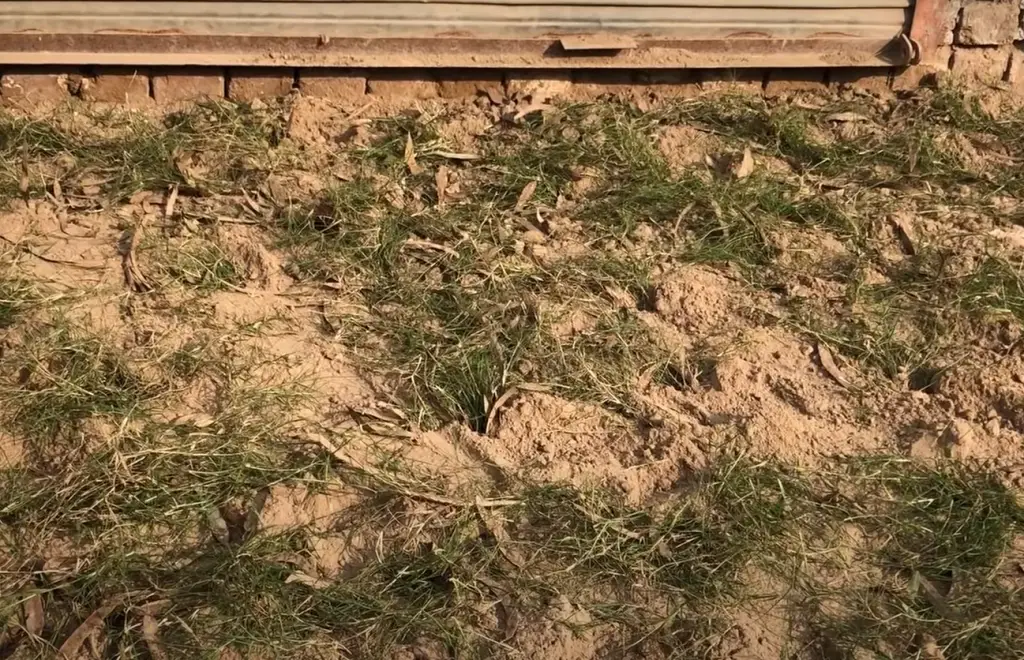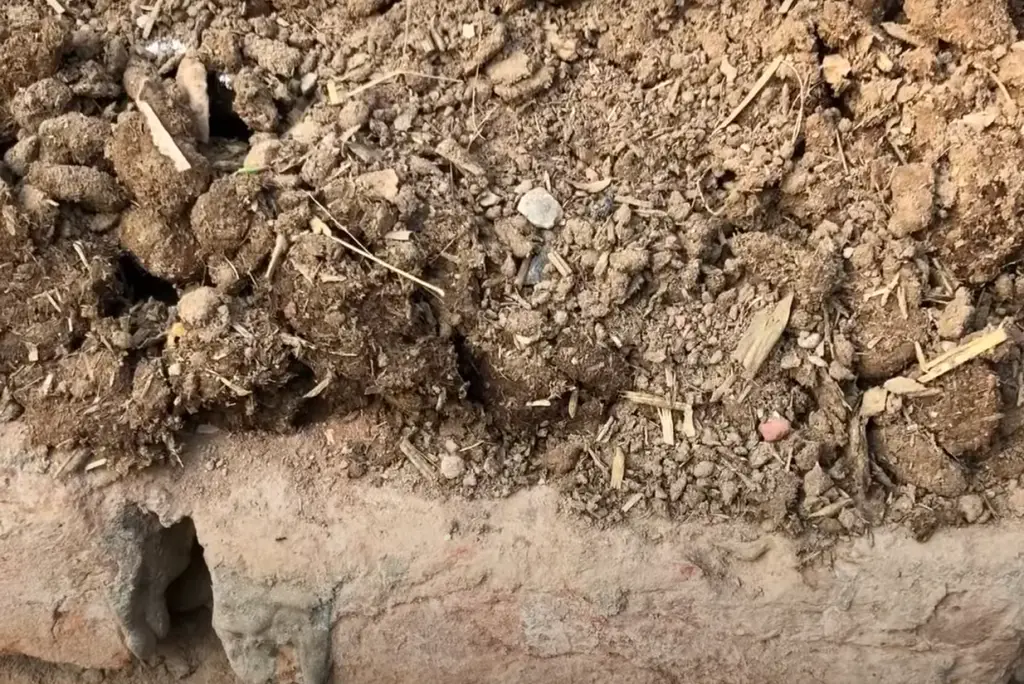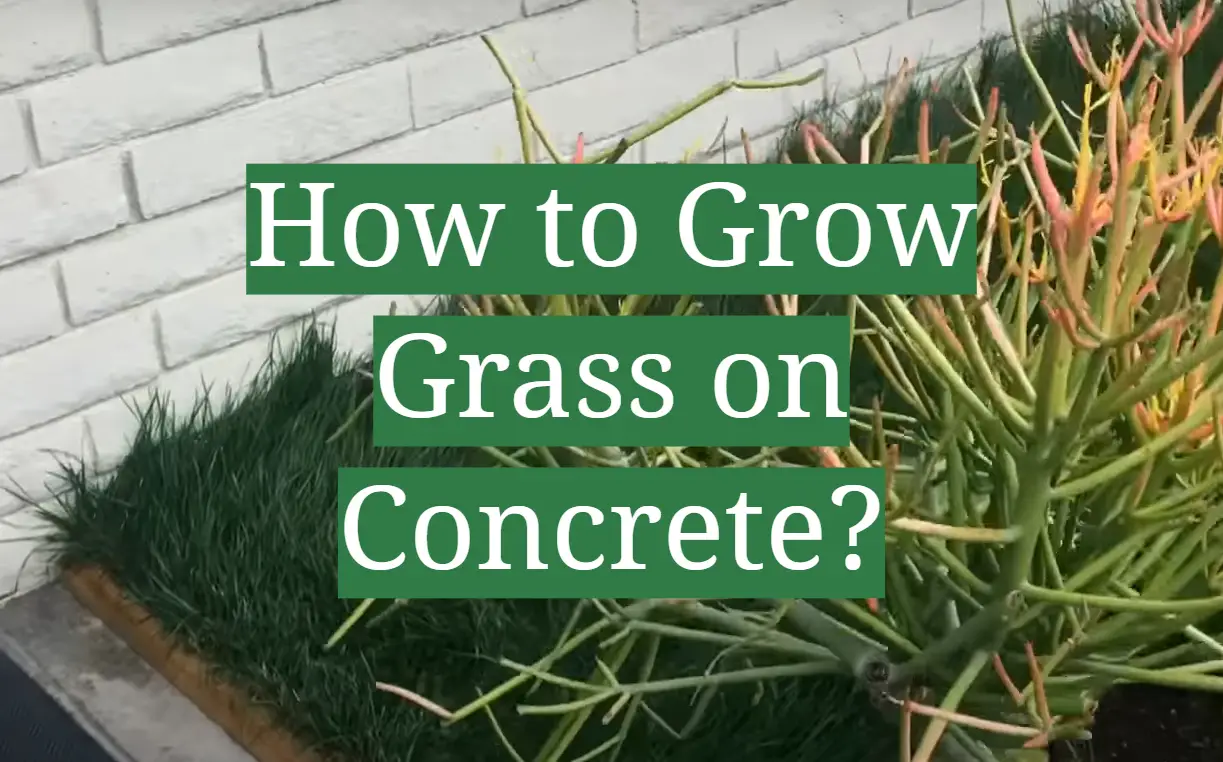If you want to add a touch of green to your concrete driveway or patio, the good news is that growing grass on concrete isn’t impossible. With the right methods and materials, you can turn even the most barren of concrete slabs into lush, luscious turf.
In this article, we’ll cover all the steps involved in getting your grass to grow on concrete – from preparation to watering and maintenance. We’ll also answer some frequently asked questions about the process so you can get started with confidence.
Is It Possible To Grow Grass Over Concrete?
Yes, it’s possible to grow grass on concrete – but you’ll need to make sure the conditions are just right if you’re hoping for a successful result. The key idea is to create the ideal environment for grass growth: one that includes soil, nutrients and plenty of moisture[2].
What Are The Best Grasses To Grow On Concrete?
The best grasses to grow on concrete are those that can tolerate low levels of soil fertility and moisture. Cool-season grasses such as bluegrass, rye, fescue and tall fescue varieties usually fare the best. Warm-season grasses like Bermuda grass and zoysia will also do well in this environment.
Steps Required
Step 1: Clean Up The Concrete Space
The first step in growing grass on concrete is to clean up the area you wish to plant. Remove any debris, dirt or weeds that may be present and sweep away loose dust and dirt particles.

This will help ensure your seeds have a clear space to grow without competing with other plants or being hindered by debris.[1]
Step 2: Spread Topsoil
Once the area is prepped, spread topsoil over the concrete.
Step 3: Create A Slope
Next, create a slight slope in the topsoil layer to ensure adequate drainage. You can do this by gently pushing the soil up from the edges of the area and creating a shallow bowl shape. This will help prevent pooling water which can lead to root rot in your grass.
Step 4: Spread Fertilizer Over The Topsoil
Add a layer of fertilizer to the topsoil in order to give your grass seeds the nutrients they need to grow. Make sure you spread it evenly over the area and use a trowel or rake to work it into the soil.
Step 5: Plant Grass Seeds
Now it’s time to plant your grass seeds. Sprinkle the seeds over the topsoil and gently work them into the soil with your hands or a trowel. It’s important not to bury them too deep, as this can reduce their chances of germination.
Step 6: Rake
After you’ve planted your grass seeds, use a rake to gently cover them with a thin layer of soil. This will help protect the seeds from birds and other animals that may be tempted to eat them before they have a chance to grow.[1]
Step 7: Water The Grass Seeds
Grass seeds need plenty of water in order to germinate and grow. Water your grass seeds every day or two until the area is saturated. After that, you can reduce watering frequency to once or twice a week depending on weather conditions.
Challenges
Feeble And Dying Grass
If you’re having trouble getting your grass to grow or it’s looking weak and dying, the most likely culprit is inadequate drainage. Make sure the soil layer is sloped properly and check for pooling water after heavy rainstorms.

If you find standing water in the area, use a shovel to create additional drainage paths that will allow excess moisture to escape.
Water Clogging
Another common issue is water clogging. If the soil is too dense, it will not absorb water easily and this can lead to pooling. To prevent this from happening, make sure your soil layer isn’t packed down too tightly and add organic matter such as compost or mulch to help aerate the soil.[2]
Lack Of Nutrients
Grass needs a steady supply of nutrients in order to grow and stay healthy. If your grass is looking weak, yellow or brown, it may be due to a lack of nitrogen in the soil. You can fix this problem by adding fertilizer to the area on a regular basis.
High Maintenance
Growing grass on concrete requires a lot of maintenance. You’ll need to water your grass regularly and keep an eye out for pests such as weeds, insects and fungi that may cause problems. You may also need to use herbicides or fertilizers in order to maintain the health of your lawn.[2]
Tips for Maintaining Grass Grown On Concrete
- Water deeply and infrequently. This will help ensure your grass gets enough water without the risk of root rot.
- Mow regularly to keep your lawn healthy and free of excess debris.
- Consider using a mulching mower, as this will help return nutrients to the soil while cutting down on lawn waste.
- Aerate your lawn once a year to ensure proper drainage and air circulation.
- Give your grass some extra TLC by applying fertilizer or compost every few months.
- Keep an eye out for signs of pests or disease, and take steps to eliminate them as soon as possible.
How to Prevent Grass From Growing on Concrete?
Herbicides
One of the most effective ways to stop grass from growing on concrete is with herbicides. There are a variety of products available that can be applied directly to the concrete surface in order to prevent unwanted plants from taking root.
Polypropylene Fabric
Another option is to cover the concrete with a layer of polypropylene fabric.

This type of material will prevent any light or moisture from reaching the concrete below, thus preventing grass and other plants from taking root in the area.
Mulch
You can also use mulch as a way to keep grass and weeds from growing on your concrete. Mulch will help block out light and moisture, as well as providing an extra layer of protection against pests and disease. Just make sure to replenish the mulch every few months in order to keep it effective.[1]
Hot Water And Salt
One of the simplest solutions is to pour a mixture of hot water and salt over the area. This will help kill off any existing vegetation and help keep new growth at bay. Be sure to test this method on a small section first, as it can have an adverse effect on concrete if used in large amounts or too frequently.
Vinegar
Vinegar is another effective way to prevent grass from growing on concrete. Just mix one part vinegar with five parts water and pour it over the affected area. The vinegar will act as an herbicide, killing any existing vegetation while also preventing new growth. Be sure to use a solvent-free variety of vinegar for best results.[1]
Baking Soda
Baking soda can also be used to stop grass from growing on concrete. Mix one part baking soda with three parts water and pour it over the area. The baking soda will act as an herbicide, killing any existing vegetation while also preventing new growth. This method is safe and effective, but remember to use it sparingly or else you may end up with an excessive build up of salt in the soil.
How to Apply Weedicide on Grass?
When weeds become a problem in your lawn, applying weedicide is the best way to get rid of them. Weedicides are usually applied with either a sprayer or a granular spreader but whichever method you choose, it’s important to read and follow all directions carefully before use.[2]
Sprayer
Using a sprayer is the most effective way to apply weedicide on grass. Simply fill the sprayer with the recommended amount of weedicide and then apply it directly to the affected area in a uniform manner. Be sure to avoid overspraying as this may cause damage to surrounding plants or lawns.
Granular Spreader
If you’re using a granular spreader to apply weedicide, make sure you follow the instructions carefully. Fill the spreader with the appropriate amount of product and then walk back and forth over the affected area in overlapping rows.

Be careful not to overspray or put too much product in one spot as this can lead to scorching of the grass.
Can you Lay Real Grass on Concrete?
Yes, you can lay real grass on concrete. The process is fairly straightforward, but will require some preparation and effort before it can be done successfully. First, you’ll need to remove any existing vegetation in the area with a shovel or tiller. Then, create a four-inch layer of soil over the top of the concrete and add a mix of organic matter such as compost or mulch to help aerate and enrich the soil. Finally, lay a roll of turf over the prepared area and water it regularly to ensure that your grass takes root and grows. With some care and maintenance, you can have a beautiful lawn on top of your concrete in no time!
Can You Grow Grass on Concrete?
Yes, you can grow grass on concrete by following the steps outlined above.
Just be sure to use high-quality soil and organic matter when creating your base layer and water regularly to ensure that your grass has enough moisture to take root and grow. With some patience and dedication, you can turn that concrete slab into a lush green lawn in no time!Minimal Soil Depth for Grass on Concrete
It is important to note that the minimal soil depth for grass on concrete should be around four inches. This will provide enough space for the grass roots to grow and take hold in the soil, which will help ensure a healthy lawn. Keep in mind that the thicker the layer of soil you use, the better chance your grass has of taking root and flourishing over time. Be sure to add plenty of organic matter such as compost or mulch to enrich the soil and help provide nutrients for your grass.
Will Grass Damage Concrete?
No, grass will not damage concrete. However, if the roots are too close to the surface of the concrete, it is possible for them to cause cracks over time.

To prevent this from happening, you should make sure that the minimal soil depth for grass on concrete is four inches and keep an eye out for any signs of root growth near the edge of your slab. If you notice any roots starting to encroach on the edge of your concrete, take steps to trim them back and ensure that your lawn remains healthy and attractive.[2]
FAQ
Can I put soil on top of concrete?
Yes, you can put soil on top of concrete. However, it’s important to note that the minimal soil depth for grass on concrete should be about four inches in order to provide enough space for the roots to grow and take hold in the soil. You’ll also need to make sure that you use high-quality soil and organic matter such as compost or mulch to enrich the soil and help provide nutrients for your grass.
Can you put artificial grass on concrete?
Yes, you can put artificial grass on concrete. This is a great option if you are looking for an easy and low-maintenance way to transform your outdoor space into a lush green lawn. However, it’s important to note that the artificial turf should be installed over a base layer of soil in order to protect the concrete from damage due to root growth. Make sure to follow the manufacturer’s instructions carefully when installing your artificial turf.
Can you put real grass on a balcony?
Yes, you can put real grass on a balcony. However, it’s important to make sure that the balcony is structurally sound and capable of bearing the weight of soil and grass before doing so. Additionally, be sure to provide enough space for the roots to grow by creating a four-inch layer of soil over the top of the concrete.
Does water drain through artificial grass?
Yes, water does drain through artificial grass. Artificial turf has drainage holes that allow the water to pass through and evaporate from the soil beneath it. This helps prevent any standing water from accumulating on the surface and causing damage to the underlying concrete slab. Additionally, some synthetic grass also features a sand infill layer that helps absorb excess moisture and promote better drainage.
Does artificial grass go Mouldy?
No, artificial grass does not go mouldy. Artificial turf is made from synthetic materials that are resistant to mold and mildew growth, so you don’t have to worry about it going mouldy or developing any other type of fungal growth over time. However, if the area where your artificial turf is installed is prone to flooding or has high levels of humidity, it may be a good idea to invest in an anti-fungal treatment to help protect your turf from mold and mildew.
Can you put fake grass on a concrete balcony?
Yes, you can put fake grass on a concrete balcony. This is a great option if you are looking for an easy and low-maintenance way to transform your outdoor space into a lush green lawn without having to worry about mowing the grass or dealing with pests. Just be sure to install the artificial turf over a layer of soil in order to protect the underlying concrete slab from damage due to root growth. Additionally, be sure to follow the manufacturer’s instructions carefully when installing your artificial turf.
Is artificial grass waterproof on balcony?
Yes, artificial grass is waterproof on balconies. This makes it a great choice for outdoor areas where you don’t want to worry about water pooling up and causing damage to the underlying concrete slab. Additionally, some synthetic grass also features a sand infill layer that helps absorb excess moisture and promote better drainage. However, it’s important to note that although artificial turf is resistant to water damage, it’s still important to clean up any standing water that may accumulate on the surface and take steps to protect your turf from extreme weather conditions such as heavy rains or hail.
What is the alternative to artificial grass on concrete?
The alternative to artificial grass on concrete is real grass. While it takes a bit more work and dedication to maintain, there are many benefits to having a natural lawn over an artificial turf. For one, soil provides the perfect environment for organic matter such as compost or mulch to enrich the soil and provide nutrients for your grass; this is something that artificial turf cannot do. Additionally, real grass is more aesthetically pleasing and can help you create a lush green outdoor space without the need for any chemicals or artificial materials.
How do you fake grass on a balcony?
In order to fake grass on a balcony, you will need to install artificial turf over a layer of soil. This is important in order to protect the underlying concrete slab from damage due to root growth. Additionally, be sure to follow the manufacturer’s instructions carefully when installing your artificial turf and take steps to ensure that there is proper drainage beneath it in order for water not to pool up. Finally, be sure to pick a high-quality artificial turf that is resistant to water damage and extreme weather conditions such as heavy rains or hail.
Useful Video: Real Grass On Concrete, it can be done – Sod salvaged from home depot dumpster. 🙌
Conclusion
Growing grass on concrete can be a challenging but rewarding task. However, with the right preparation and care, you can create a lush green outdoor space that is both aesthetically pleasing and easy to maintain. Whether you choose to go with real grass or artificial turf, follow these tips and use the answers to FAQs above to help give your lawn the best chance at success. Good luck and happy gardening!
References:
- https://www.fallsgarden.com/growing-grass-on-concrete/
- https://flourishingplants.com/grass-growing-on-concrete/










Leave a Reply
View Comments